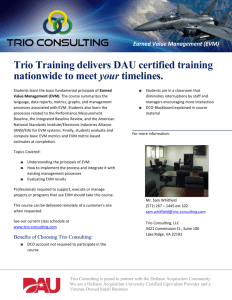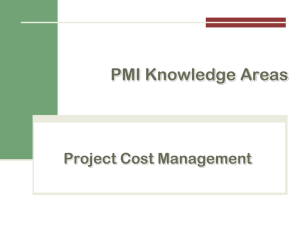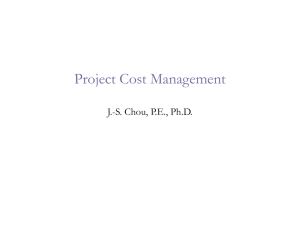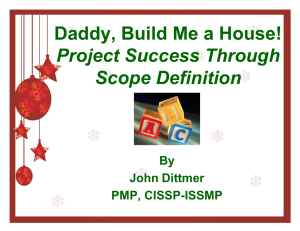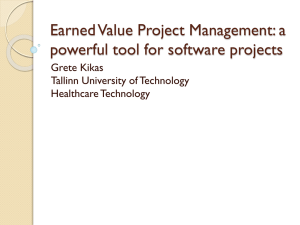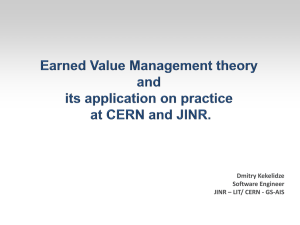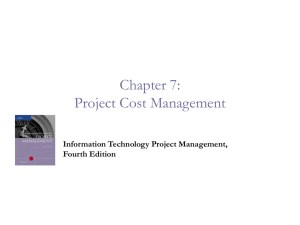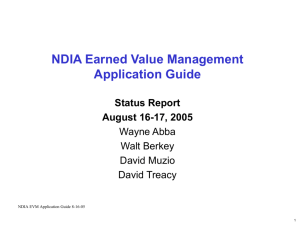EVM: A Simple Concept
advertisement
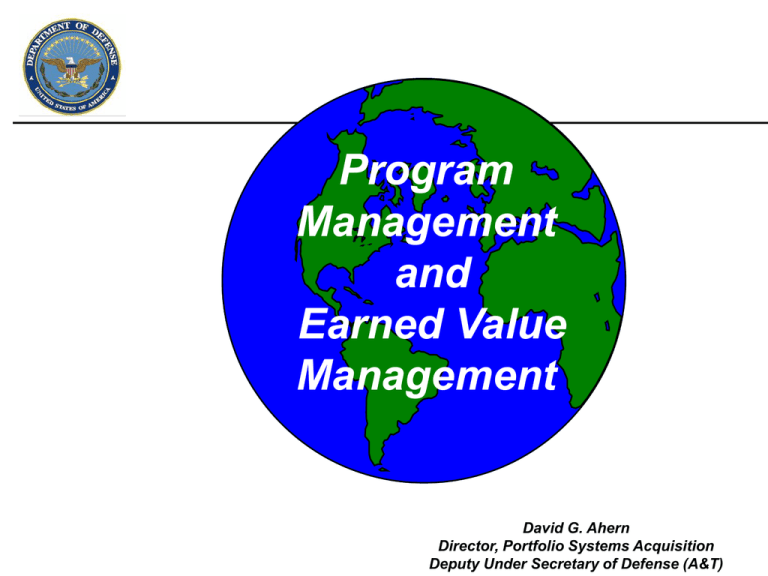
Program Management and Earned Value Management David G. Ahern Director, Portfolio Systems Acquisition Deputy Under Secretary of Defense (A&T) Agenda • • • • • Interdependencies & Government/Industry Dynamics Principles of Program Management Data Quality & Integrity EVM-Related Issues/Challenges Improving Program Performance & Collaboration Program Manager's Challenge: Striking The Right Balance PROGRAM • • • • GOVERNMENT • • • • REQUIREMENT CONTRACT TYPE TERMS AND CONDITIONS AWARD AND ADMINISTRATION PERFORMANCE COST SCHEDULE SUPPORTABILITY INDUSTRY • PRODUCT PERFORMANCE • INVESTMENT • FINANCING/CASH • PROFIT Understanding Government/Industry Dynamics Cost Growth Sales & Profit $200,000 $65,000 $25,000 Sales / Revenue $180,000 Earnings / Profit $60,000 $160,000 $55,000 $140,000 Est. Cost Growth $50,000 $45,000 $40,000 DIVERGENT CENTERS OF GRAVITY $20,000 $120,000 $15,000 $100,000 $80,000 $10,000 $60,000 $40,000 $35,000 $5,000 $20,000 $30,000 Orig. CBB EAC $0 $0 2001 2002 2003 2004 2005 2006 CUSTOMER MARKET Warfighter / Taxpayer Stockholder Program Performance Financial Performance Cost / Schedule / Technical Sales / Profit / Cash Flow We Must Find A Balance 4 RDT&E Cost Growth DEVELOPMENT COST GROWTH BY CATEGORY AVG RDT&E COST GROWTH FROM ACQUISITION PROGRAM BASELINE ESTIMATING ASSUMPTIONS 20% • CER’s • LABOR RATES • CA TO CDR • CDR TO FIRST FLT • FIRST FLT TO IOC (ACROSS ALL PROGRAMS) 65% SCHEDULE ASSUMPTIONS 21% TECHNICAL BASELINES 59% • WEIGHT • VOLUME • COMMONALITY • SOFTWARE • # TEST ARTICLES • # TEST FLIGHTS Development Programs Experiencing Significant Cost Growth From Acquisition Program Baselines Principles of Program Management • Set the baseline – what is the task? – Performance, Cost, Schedule, and Risk • Integrated Product and Process Development – Optimize the design, manufacturing, and supportability processes – By integrating all essential acquisition activities through the use of multidisciplinary teams. • Dynamic Environment – Expect Changes – Communicate, Cooperate • Measurement and Reporting – EVM, C/SSR Reporting DoD Program Management TWO DISTINCT BUT RELATED AREAS OF FOCUS Acquisition Program Management • Acquisition Planning • APB • Source Selection Plan • Award Fee • SAR/DAES Integrated Project Management (IPM) • Project Status/CPI & SPI • Estimate at Completion • Staffing • Tasks Completed • Management Processes • Risk Mitigation • Technical Reviews IPM/EVM Is Not Just CPI & SPI IPM Cost Schedule Technical 7 Integrated Project Management Earned Value Management PLANNING • • • • • • • • • • • Contract Requirements Source Selections Award Fee Criteria Program Item Descriptions (PID) Management System Assessments (MSAs) Integrated Baseline Reviews (IBRs) Integrated Master Schedule (IMS) Cost Analysis Requirements Description (CARD) Risk Identification Key Performance Indicators (KPPs) Resource Forecasts EXECUTION IPM Cost Schedule Technical • Technical Reviews (PDR, CDR, etc.) • Management System Assessments (MSA) • Integrated Baseline Reviews (IBRs) • Award Fee Determination • Schedule Risk Assessments (SRAs) • Program Management Baseline (PMB) • Estimates at Completion (EACs) • Risk Mitigation • Program Performance Measurement • Burn Rate Trends • Management Reserve Usage • Staffing Plans • Baseline Execution Evaluations IPM = Cost, Schedule And Technical Integration “The Application of Basic Project Management Principles” 8 Leading Indicators – Contractor Staffing And Task Completion MACRO ANALYSIS MICRO ANALYSIS Month 48 0 1 2 1400 1000 Full-Tim e Equivalents (FTEs) 1200 INCOMPLETE WORK 800 600 400 3 4 5 6 7 8 Year 2 Year 3 9 10 11 12 13 14 15 16 17 18 19 20 21 22 23 24 25 26 27 28 29 30 31 32 33 34 35 36 Award Feb-06 M ar-06 Apr-06 M ay-06 Jun-06 Jul-06 Aug-06 Sep-06 O ct-06 N ov-06 D ec-06 Jan-07 Feb-07 Mar-07 Apr-07 May-07 Jun-07 Jul-07 Aug-07 Sep-07 Oct-07 Nov-07 Dec-07 Jan-08 Feb-08 M ar-08 Apr-08 M ay-08 Jun-08 Jul-08 Aug-08 Sep-08 Oct-08 Nov-08 Dec-08 Jan-09 Month 47 Month 46 Month 45 Year 1 Month 44 Month 43 Month 42 Month 41 Month 40 Month 39 Month 38 Month 37 Month 36 Month 35 Month 34 Month 33 Year 4 Month 32 Month 31 Month 30 Month 29 Month 28 Month 27 Month 26 Month 25 Month 24 Month 23 Month 22 Month 21 Year 3 Month 20 Month 19 Month 18 Month 17 Month 16 Month 15 Month 14 Month 13 Month 12 Month 11 Month 10 Month 9 Year 2 Month 8 Month 7 Month 6 Month 5 Month 4 Month 3 Month 2 Award Year 1 800 700 600 500 400 300 200 100 0 -100 -200 -300 -400 -500 -600 -700 -800 -900 -1000 -1100 -1200 UNDERSTAFFED * equivalent of 3 man-months per person P lanned S taff A ctual S taff C ontracted S taff N ext six m onths staffing plan Last M onth's six m onth staffing plan A ctual m an-m onths over or under plan C um ulative m an-m onths over or under plan 200 0 STAFFING SHORTFALL B a s e l in e E x e c u tio n 400 S t ill In c o m p le te F in is h O ve r O n e M o n t h L a te F in is h le s s t h a n O n e M o n t h L a t e F in is h O n Tim e F u t u re t a s k p la n n e d F in is h E a rly 350 -200 300 -400 N u m b er o f T a sk s 250 INCOMPLETE WORK -600 200 150 -800 * >40% of delinquent tasks not yet started -1000 -1200 100 50 8 8 -0 b e F 7 7 -0 an J 7 0 -0 -0 v ec o N D 7 7 -0 tc O 7 0 -0 l- g p u u e S A 7 7 -0 y -0 n a p u J J M 7 7 7 0 r -0 -0 a e b r- A F M 6 6 6 7 -0 J an -0 ec D 6 0 -0 v tc O o -0 -0 p g u Program C Cumulative Understaffed e Program C Incomplete Tasks Program B Cumulative Understaffed S Program B Incomplete Tasks Program A Cumulative Understaffed A Program A Incomplete Tasks N 6 0 -1400 INITIAL RESULTS INDICATE FEW CONTRACTORS HAVE THE CAPABILITY TO DEVELOP AND MAINTAIN A HEALTHY INTEGRATED MASTER SCHEDULE. LAUNCHED THREE ANALYSIS ACTIVITIES – – – SCHEDULE CAPABILITY SKILLS STAFFING ENVIRONMENT SUBCONTRACTING ENVIRONMENT PRIMES WHO SUBCONTRACT LARGE PORTIONS OF WORK EXPERIENCE GREATER SCHEDULE DEVELOPMENT & MAINTENANCE DIFFICULTY, PARTICULARLY IF WORK IS SUBBED USING FFP. PRIMES ARE EXPERIENCING SKILLS SHORTAGES AND OVERAGES – MOST ARE INCAPABLE OF ACCURATELY PREDICTING OR FULFILLING SKILLS DEMANDS FOR +1 MONTH. SUBCONTRACTED WORK IS INCREASING; UP TO 7-FOLD INCREASES IN BUY DECISIONS OVER PRIOR EFFORTS, UP TO 3-FOLD INCREASES IN SKILLS SUBCONTRACTING FOR DESIGN EFFORTS. Skills Staffing And Task Completion Inextricably Linked Program Management Tools • Type of Contract • Length of Contract • Technical Maturity • Integration • Constant Vigilance –Accurate, rolling baseline –Continuous, timely, accurate, execution data How are DoD Contracts Performing? Notional data for illustrative purposes only Program “X” Enterprise Data Quality Dimensions EV / Funding Data Quality Funding Data Quality: Acceptable for Critical Measurements and Decision-making EVM Data Quality: Unacceptable for Critical Measurements and Decision-making EVM Data Integrity EVM-Related Issues/Challenges • EVM requirements incorrectly placed on contract • Contract incentives that counter EVM’s objectives • Deficiencies in contractor EVM systems • Lack of timely, realistic, and executable performance measurement baselines OSD and DCMA have identified several EVM implementation issues on DoD contracts EVM Requirements • Issue: EVM requirements incorrectly placed on contract – – – – – – • EVM not being used as management tool; perception EVM is just a financial report Failure to include applicable EVM requirements Inappropriately modifying EVM requirements; incorrectly tailoring DIDs for CPR and IMS Specifying contract requirements not consistent with EVM policy and EVMS guidelines Use of EVM not considered in contract type selection decisions Disallowing use of contractor’s EVMS on contracts not requiring reporting Action: Ensure EVM requirements are identified and incorporated into solicitations and contracts, and are then properly executed – – – – – – Work closely with program manager and EVM community throughout acquisition process Involve EVM subject matter experts in establishing and implementing contract requirements (statement of work (SOW), request for proposals (RFP), CDRLs) Consider EVM implications when selecting contract type Discuss requirements in pre- and post-award conferences or similar forums Include EVM on agenda at contracting meetings and conferences Ensure the “right” EVM training is provided to contracting community It’s important to get the EVM requirements right up front – fixing problems later is more painful … and costly Contract Incentives • Issue: Contract incentives that counter EVM’s objectives – Contracting policies can work at cross purpose with EVM – Use of award fee incentives that drive undesired behavior – incentivizing achievement of good numbers rather than good performance – Result is PMs are denied objective performance information on their programs • Action: Find better ways to incentivize contractors (better use of fees) – Avoid use of cost and schedule indices (CPI and SPI) as only EVM-related award fee criteria – Work with EVM community to devise objective, yet effective, contract incentives – Consult EVMIG for ideas on appropriate EVM-related incentives (e.g., realistic and current cost and schedule forecasts) Paying contractors to maintain cost and schedule indices within predetermined boundaries encourages undesirable behavior Contractor EVM Systems • Issue: Deficiencies in contractor EVM systems – – – – – – – – – • Lack of knowledge by control account managers Span of control issues Inadequate schedules Data integration and integrity problems Undisciplined work authorization and change control processes Poor variance analyses No formal corrective action processes Inadequate estimate at completion procedures EVM used to report data, not to manage Action: Contact DCMA for help with contractor EVMS problems – Work with local DCMA EVM specialist and/or the EVM Center – Implement appropriate remedial actions for EVMS non-compliance Based on findings from recent DCMA EVMS compliance reviews Baseline Planning/Execution • Issue: Lack of timely, realistic, and executable Performance Measurement Baseline (PMB) – – – – • Conduct of IBRs impacted by delays in defining work scope Contractual direction to defer baseline planning until definitization Incongruities between SOW and PMB (e.g., undefinitized contract actions) Lag time in incorporating changes into baseline Action: Know, understand, and implement ways to improve timeliness and quality of baseline planning and execution – Ensure IBRs are conducted within 180 days after contract award, and after exercise of significant options or major modifications – Stop direction to delay baseline planning until after contract definitization – Incorporate authorized unpriced work into PMB – detail plan near-term effort – Work with EVM community to ensure integrity of work scope and PMB – achievable contract schedule and proposal estimate Establishing an executable baseline is a critical prerequisite to the successful implementation of EVM Improving Program Performance lessons learned REQUIREMENTS DEFINITION M/S A DAB JROC JROC ICD ICD ++ CONOPS CONOPS Draft Draft ICD ICD Draft Draft CDD CDD ++ CONOPS CONOPS Rev Rev 00 1 Draft Draft CDD CDD ++ CONOPS CONOPS Rev Rev 1..n 1..n Final Final CDD CDD ++ CONOPS CONOPS 3 2 4 5 AoA AoA Preferred Preferred System System Concept Concept System System Definition Definition (SDS) (SDS) System System Spec Spec Technology Development & System Requirements Development Maturity Assessment & Technology Demonstration Concept Refinement 6 SSA TMA TMA Assessment Assessment Production Production Spec Spec RFP RFP System Development and Demonstration Models &/or Prototypes Defense Acq System ASR ITR Phase 0 SRR I Phase I AoA: Analysis of Alternatives CDD: Capability Development Document FSA: Functional Solution Analysis RFP: Request For Proposal SDS: System Design Specification SRR II SFR Test Articles PDR CDR Phase II Phase III KEY: TMA: Technology Maturity Assessment DAB: Defense Acquisition Board JROC: Joint Requirements Oversight Council ICD: Initial Capabilities Document SSA: Source Selection Authority Technical Underpinnings Cost Risk Assessment Schedule Risk Assessment Technical Risk Assessment Solid Understanding of Requirements Realistic Baseline PARTNERING WITH INDUSTRY INFORMATION VISIBILITY Boeing Common WBS Elements LRE in $,000 $60,000 LRE Variance $ $50,000 $40,000 $30,000 UNFAVORABLE $20,000 FAVORABLE $10,000 $0 ($10,000) ($20,000) Collaborative Process Overhead Management Reserve General & Administrative Flight Control Field Services Cost of Money Product Assurance Configuration Mgmt Undistributed Budget Furnishings / Equipment Program / Project Management Loading / Payloads / Equipment Services Air Vehicle Technology Survivability Information Systems Testing & Evaluation Crew Station / Systems Maintenance Instructions Logistical Support Analysis Design to Cost / Life Cycle Cost Wing Other Supportability / Support Equipment Training Avionics Airframe ECP / LLP In Service Engineering Data / Software - Handling & Management Armament Propulsion Landing Gear Instructions / Publications Electrical & Electrical Systems Fuselage Flight Test Repairability Environmental Penetration Aids Targeting & Sensors Communication / Navigation Supplier / Supply Chain Mgmt Systems Engineering / Integration ($30,000) Cockpit Mgmt, Controls, & Display lessons learned AoA AoA Plan Plan Hydraulics / Pneumatics / Mechanical EXECUTION PLANNING FSA Improvement Activity “Lean Six Sigma” Continuous Improvement lessons learned Burning Platform Cockpit Chart Leading Indicators Transform Data into Information lessons learned JCIDS PROGRAM BASELINE M/S B DAB M/S A’ Summary • We must improve program execution • Program Management is key to program success – PMs must have mutual understanding of the task • EVMS should provide an accurate picture of program status relative to the baseline plan – If data quality and integrity are suspect, then “garbage in-garbage out” applies • We must collaborate to improve EVM system implementation and PM’s comprehensive understanding/use of the data
